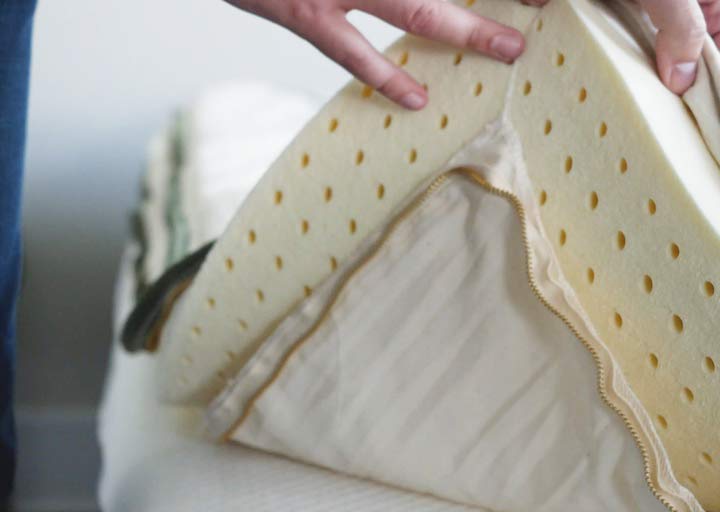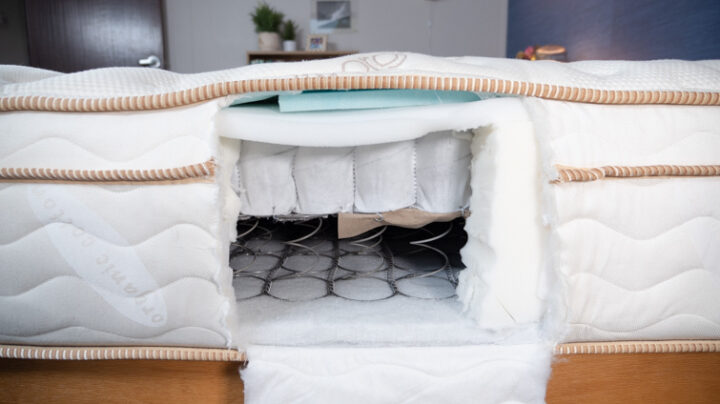Looking for a supportive, cooling bed but not sure if latex or innerspring is the best choice for you? We’ve got you covered. Below, we’ll break down the similarities and differences between these two mattress types, plus make some recommendations on which one is best for your needs.
Read on to learn which of these springy beds is a match for you.
Latex vs Innerspring: General Overview
Check out the chart below for some quick facts about innerspring and latex beds.
|
Latex Mattresses |
Innerspring Mattresses |
|
|
Average Cost (Queen Size) |
$1,500 – $2,200 |
$700 – $1,500 |
|
General Comfort |
Latex mattresses work well for sleepers who like springy mattresses that are available in a variety of firmness options. |
Innerspring mattresses are good picks for sleepers who like firm, supportive beds that have a bouncy feel. |
|
Materials Used |
Dunlop or Talalay latex foam, steel coils, |
Steel coils, foam |
|
Average Lifespan |
20+ Years |
5-10 Years |
|
Pros |
Cooling, durable, responsive |
Supportive, bouncy, affordable |
Top Similarities
- Innerspring and latex mattresses are both very cooling, and they work well for hot sleepers.
- Both mattress types are great for combination sleepers. They offer plenty of responsiveness, making it easy to change sleeping positions.
- High-quality latex and innerspring mattresses are very supportive. This makes them good options for heavy people. In fact, our best mattresses for heavy people roundup features both innerspring and latex options.
- These mattresses don’t offer much body contouring.
Key Differences
- Innerspring mattresses tend to be more affordable than latex mattresses.
- Latex mattresses are more eco-friendly than innerspring mattresses, and are often naturally hypoallergenic and resistant to dust mites. This makes them a better fit for environmentally conscious shoppers.
- Traditional innerspring mattresses usually feel firmer than latex mattresses.
What is a Latex Mattress?
Latex mattresses feature layers of Dunlop or Talalay latex. Sometimes these beds are made entirely of latex foam, and sometimes they combine latex with metal coils. Check out our What Is Latex article to learn more about latex beds.

Types of Latex Mattresses
Latex mattresses can be made of natural or synthetic latex. Most latex beds are made of a blend of both. All latex is made out of rubber tree sap, but different types of latex have different feels.
Dunlop latex beds feel firm and supportive. They are great options for sleepers with back pain. Dunlop latex is made from the sap of the rubber tree that has been heated up and cooled back down. It is different from Talalay latex, which is heated up and then flash frozen to preserve larger air bubbles.

Talalay latex beds feel softer and conform to your body shape. We recommend Talalay latex beds for side sleepers or those looking for extra pressure relief.
Latex Mattress Benefits
Latex mattresses offer a lot of benefits! Organic latex mattresses are great picks for anyone looking for a bed made of natural materials. A natural latex mattress often combines latex layers with organic wool and cotton and is a great pick for anyone with sensitive skin. Natural latex mattresses are also great options for sleepers with asthma who are looking to avoid dust mites and other allergens.
Any latex mattress, whether natural or synthetic, will offer great airflow. Latex is a cooling material that’s naturally breathable.
Latex beds are also quite durable. They can last over twenty years. If you’re looking for a mattress that will make good on its lifetime warranty, a latex mattress is the right fit for you.
Finally, latex is springy and comfortable. It is offered in a variety of firmness levels, but it will lift you “up and out” of your bed no matter how soft your sleeping surface is.
Latex Mattress Considerations
Latex is not a good fit for sleepers who prefer a slow-moving feel. Latex does not conform to your curves the way memory foam does. Additionally, latex mattresses tend to allow a lot of motion transfer, which means you will feel a partner moving around on the other side of a latex bed.
Latex mattresses are also one of the most expensive types of mattresses available. If you don’t have a big budget set aside for your new mattress, you might want to consider a different material. That said, many shoppers feel latex is worth the investment because of its durability.
What is an Innerspring Mattress?
Innerspring mattresses contain steel coil support systems. Usually, a base of firm pocketed coils supports a softer coil system on top. Some innerspring beds include top layers of foam to offer a little bit of body contouring and pressure relief. But in general, these beds feel much firmer than foam beds. Check out our What is an Innerspring Mattress article for more details.

Innerspring Mattress Benefits
Innerspring beds feel firm, supportive, and bouncy. It makes them very popular with back sleepers, stomach sleepers, and people who enjoy a traditional feel.
Like latex mattresses, innerspring beds are very cooling. So hot sleepers who like firm beds might enjoy innerspring mattresses.
Finally, there are a wide variety of innerspring mattress options available. So, you can find a durable innerspring mattress on a low budget. You can also find high-end innerspring mattresses that offer a more luxurious feel. Innerspring mattresses also work well as a nice firm base for mattress toppers, so it is easy to spruce up a budget bed if you go the innerspring route.
Innerspring Mattress Considerations
Innerspring mattresses do not offer good motion isolation. So, you’re likely to be disturbed by a partner on an innerspring bed.
Innerspring mattresses also don’t offer the best pressure relief. Side sleepers or those looking for joint pain relief might prefer a latex or pillow top mattress. Innerspring beds can’t conform to joints the way other beds can. Consider mattress materials like memory foam if you’re looking for a body-contouring feel.
Latex vs Innerspring Mattresses: Which Should You Get?
The answer ultimately depends on your personal preferences, but we’ll point you in the right direction.
Who Should Get a Latex Mattress?
- Sleepers looking for a natural, hypoallergenic mattress
- Sleepers who prefer a softer feel
- Those looking for a particularly durable mattress
Sound like you? Check out the Best Latex Mattresses roundup.
Who Should Get an Innerspring Mattress?
- Back and stomach sleepers
- People who prefer traditional, bouncy mattresses
- Budget shoppers looking for a high-quality bed
Take a look at our Best Innerspring Mattresses to find an innerspring bed that meets your needs.
FAQs
Before we wrap up, we’ll answer some of the most frequently asked questions.
Are latex mattresses heavy?
Yes. Because latex foam is very dense, latex mattresses can be very heavy. You may need help unboxing a latex mattress.
Are innerspring mattresses toxic?
No, innerspring mattresses are not toxic. You can find innerspring mattresses made from natural materials if you are concerned about sleeping on polyurethane foams.
Are latex mattresses toxic?
No, latex mattresses are not toxic. Latex is a naturally fire-resistant foam, which means latex beds are not coated in chemical flame retardants.
Can latex mattresses cause allergies?
Latex mattresses are naturally hypoallergenic, but they could cause issues for people with latex allergies. Most latex mattresses contain thick covers that prevent allergic reactions, but some people may prefer to err on the side of caution and avoid the material.
Do innerspring mattresses need a box spring?
Traditional innerspring mattresses require a box spring for proper support. Modern innerspring and hybrid mattresses do not require a box spring. Check with the retailer to learn if the specific innerspring mattress you are considering requires a box spring.

